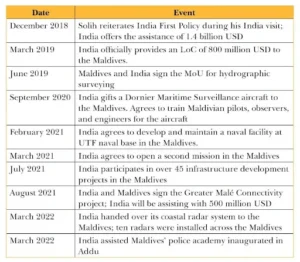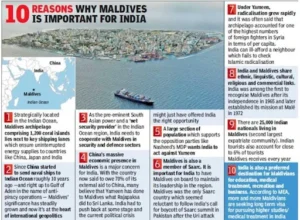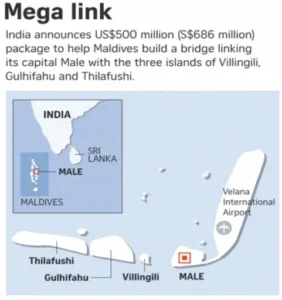Introduction
- India and Maldives recently agreed to elevate the ties to a comprehensive economic and strategic partnership, as Prime Minister Narendra Modi met the President of Maldives Mohamed Muizzu in New Delhi.
- PM Modi underscored the importance attached by India to its relationship with Maldives under its ‘Neighbourhood First’ Policy and Vision SAGAR.
- PM Modi described India as the “first responder” for Maldives, in times of crisis — from the pandemic to drinking water shortage. He also said they have decided to start negotiations for a Free Trade Agreement.
- The two leaders also witnessed the exchange of five pacts — including one on currency swap.
- India and Maldives signed 5 key pacts including one on currency swap. Other pacts are on training of judicial officers, prevention of corruption, law enforcement training, sports and youth affairs.
Read also: State Control of Temples: Faith vs. Governance | UPSC
Recent Key Pacts Between India and Maldives
- India and the Maldives inked a currency swap agreement to the tune of $400 million, a move that would help Maldives overcome foreign exchange reserve issues.
- India has decided to extend vital budgetary support to the Maldives government with the rollover of a USD 50 million Treasury Bill for another year.
- India also handed over 700 social housing units to the Maldives built under the EXIM Bank’s buyer’s credit facilities.
- Rupay card has been launched in Maldives which will enhance ease of payments for Indian tourists visiting Maldives, to work closely to extend similar services for Maldivian nationals visiting India.
- India will launch a new programme to promote women-led development by imparting skills training and extending support to Maldivian women entrepreneurs for their enhanced participation in Maldivian economy.
- India will collaborate in establishment of a Start-up Incubator-Accelerator in Maldives to harness the innovation potential of the youth.
- India will inaugurate at an early date the state-of-the-art Maldivian Ministry of Defence (MoD) building in Malé, constructed with India’s assistance, that will augment modern infrastructural capacity of the MoD.
- Inauguration of a new runway of Hanimaadhoo International Airport in the Maldives.
- PM Modi announced that work will be accelerated on the India-assisted Greater Male Connectivity Project, which aims to link key islands of the Maldives through modern transport networks.
Maldives’ Financial Crisis Overview
What is Sukuk Debt?
|
What was ‘India Out’ Campaign?
-
- The ‘India Out’ campaign is a political movement aimed at mobilizing public sentiment in the Maldives against Indian influence, particularly opposing the presence of Indian military personnel on Maldivian soil.
- The campaign gained traction during critical bilateral developments, notably following the signing of the Uthuru Thila Falhu (UTF) harbor development agreement with India in February 2021 and the announcement of India’s new consulate in Addu Atoll.
- The Uthuru Thilafalhu (UTF) agreement was proposed in 2016 under Yameen, but was signed only in 2021 under Maldives President Ibrahim Mohamed Solih.
- According to the agreement, India will help develop and maintain a coastguard harbour and dockyard for Maldives and provide professional, technical and logistical support for a period of 15 years.
- The agreement would help improve maritime security by letting the Maldives National Defence Force (MNDF) dock, maintain, and repair its coast guard vessels.
- The opposition parties in Maldives claimed that the government has allowed India to establish a military base in the Maldives.
- The opposition leaders allegedly obtained a leaked version of the document and fuelled the fears.
- The leaked document alleged that Indian military personnel will be stationed for a period of 30-60 years and use arms and communication facilities, and Indian vessels and aircraft would have unrestricted free access to the UTF.
- Prominent supporters of the campaign include Abdulla Yameen, who served as the President of Maldives from 2013 to 2018. During his tenure, Yameen adopted a pro-China stance, signing a Free Trade Agreement with China and issuing an ultimatum for the withdrawal of two Indian helicopters stationed in the strategically significant Laamu and Addu Atolls.
- The current president-designate, Dr. Mohamed Muizzu, has also rallied support for the ‘India Out’ campaign, indicating a shift in Maldives’ foreign policy focus away from India.
- India First Policy:
- The India First Policy reflects the Maldives’ preference for India as its primary partner in security cooperation, socio-development assistance, and response efforts during crises such as the COVID-19 pandemic, including vaccine distribution.
- This policy was championed by Ibrahim Mohamed Solih upon his election as President in 2018. It aimed to reverse the anti-India sentiments and policies established during Yameen’s administration, promoting a renewed partnership with India to enhance bilateral ties and cooperation.
Historical Background of India-Maldives Relations
Cultural and Ethnic Ties:
-
- India and Maldives share deep-rooted connections through ethnicity, language, culture, and religion, dating back to ancient times. The name “Maldives” likely originates from Sanskrit, where “Mala” means garland and “Dweep” means island.
- The islands have been inhabited since at least the 5th century BC by settlers from Sri Lanka and Southern India, establishing early trade relations.
Diplomatic Relations:
-
- 1965: Maldives gained independence from British rule. India was among the first countries to establish diplomatic ties, opening an Indian Mission in Male in 1972.
- 1978: Under President Maumoon Abdul Gayoom, Maldives strengthened its relationship with India through numerous visits and engagements.
Military Cooperation:
-
- 1988: India intervened militarily to help thwart a coup attempt against Gayoom, sending troops and ships to ensure stability in the Maldives.
Shift in Leadership:
-
- 2008: The election of Mohamed Nasheed marked a new chapter with increased security cooperation, including loans of helicopters and dornier aircraft for maritime security.
- 2013: Abdulla Yameen’s presidency strained relations due to his pro-China policies, including signing a Free Trade Agreement (FTA) with China and inviting significant Chinese investments including the Hullumale island housing projects and friendship bridge.
Recent Developments:
-
- 2018: Ibrahim Mohamed Solih’s election brought a renewed focus on India with the adoption of an “India-First” policy, inviting Indian investment in key infrastructure projects like the $500mn Greater Male connectivity project and Uthuru Thilafalhu project.

Significance of Maldives for India
-
- Geo-Economic Importance: Maldives is strategically located along crucial maritime trade routes. Approximately 50% of India’s external trade and 80% of its energy imports pass through the surrounding sea lanes.
- Geo-Political Role: Maldives is an active participant in various regional initiatives, such as the Colombo Security Conclave and the Indian Ocean Rim Association, SAARC, SASEC, SAGAR initiative of India. It supports India’s bid for a permanent seat on the UN Security Council. The Maldives also supports India’s bid for a permanent seat on the United Nations Security Council (UNSC), which was reaffirmed during the 2019 UN General Assembly discussions.
- Security Considerations: The Maldives serves as a frontline defense for India against maritime threats like terrorism and piracy, making it a vital area for securing India’s maritime interests. The Indian Coast Guard and the Maldivian National Defence Force (MNDF) frequently engage in joint exercises, enhancing cooperative efforts to combat maritime crimes and secure sea lanes. For example, Operation Cactus in 1988 highlighted India’s commitment to assisting Maldives in countering threats.
- Indian Diaspora: A significant Indian community resides in Maldives, contributing to sectors such as education, healthcare, and tourism, further strengthening bilateral ties. The Indian expatriate community in the Maldives is approximately 27,000 strong, with a majority of expatriate teachers hailing from India. Many Maldivians seek education in India, with over 1,000 Maldivian students enrolled in Indian universities, fostering people-to-people connections and enhancing mutual understanding.

Areas of Cooperation between India and Maldives
Economic Cooperation:
-
- India ranks as one of the largest sources of tourists to the Maldives, which relies heavily on tourism for its economic stability.
- In 2023, India led the statistics by sending the highest number of tourists to the Maldives, totaling 209,198, capturing approximately 11.8% of the market share.
- India became the second-largest trade partner of the Maldives in 2022, with bilateral trade surpassing the USD 300 million mark for the first time in 2021.
- A Bilateral USD Currency Swap Agreement was signed between the Reserve Bank of India (RBI) and the Maldives Monetary Authority on July 22, 2019.
- Indian imports from the Maldives mainly consist of scrap metals, while Indian exports include a diverse range of engineering and industrial products, such as pharmaceuticals, cement, and agricultural produce.
- India has invested over $500 million in grants and financial assistance aimed at enhancing maritime connectivity. The Export-Import Bank of India has provided an $800 million line of credit.
Infrastructure Development:
-
- Major projects include the Greater Male Connectivity Project. The project seeks to establish connections between Male and the islands of Villingili, Gulhifalhu, and Thilafushi via a network of bridges, causeways, and roads. This initiative is vital for the development of the proposed Gulhifalhu Port and is expected to serve as a significant driver for the Maldivian economy in the future, generating jobs and fostering economic activity.
- The Hanimaadhoo International Airport Development project, funded through an Indian credit line, will introduce a new terminal designed to accommodate 1.3 million passengers annually.
- In 2022, India’s External Affairs Minister inaugurated the National College for Policing and Law Enforcement (NCPLE).

Military and Security Collaboration:
-
- Maldives heavily relies on trilateral maritime security collaboration with India and Sri Lanka, making the protection of its maritime borders a top priority for the Indian government. Key areas of cooperation include:
- India and Maldives work together on maritime security, maritime domain awareness, and Humanitarian Assistance and Disaster Relief (HADR) operations.
- India has donated Landing Assault Craft and 24 Utility Vehicles to enhance Maldives’ maritime security capabilities.
- In April 2016, India and Maldives signed a comprehensive Action Plan for Defence to strengthen their defence partnership.
- India provides the majority of training for the Maldivian National Defence Force (MNDF), covering approximately 70% of their defence training needs.
- Joint security exercises such as “Ekuverin,” “Dosti,” “Ekatha,” and “Operation Shield” are regularly conducted between the two nations.
- In 1988, India launched Operation Cactus to assist the Maldivian government in neutralizing a coup attempt.
Humanitarian Assistance Cooperation:
-
- India has consistently extended support to Maldives in times of need. Some key examples include:
- A Memorandum of Understanding (MoU) was signed in 2019 between India and Maldives for High Impact Community Development Projects (HICDPs), which aim to implement several socio-economic development initiatives.
- India provided 100,000 doses of Covishield vaccines to the Maldives in January 2021 during the COVID-19 pandemic. Additionally, through Operation Sanjeevani, India supplied 6.2 tonnes of essential medicines. Two sea ambulances were also handed over to the Ministry of Defence of Maldives.
- India assisted Maldives in recovery efforts after the 2004 Tsunami and addressed a drinking water shortage in 2014 through Operation Neer.
- In the healthcare domain, India has allocated ₹52 crore for the development of the Indira Gandhi Memorial Hospital, along with support to establish a state-of-the-art cancer facility connecting over 150 health centers across various islands.
Educational Programmes:
-
- India contributed to the establishment of a technical education institute in 1996 and has initiated a program to provide training for Maldivian teachers and youth, as well as vocational training under a USD 5.3 million project.
- India also offers a significant number of training opportunities for the Maldivian National Defence Force (MNDF), fulfilling approximately 70% of their defense training needs.
Read also: University Ranking Framework: A Comprehensive Guide | UPSC
Challenges in India-Maldives Relations
-
- Political Opposition: Leaders like Dr. Mohamed Muizzu and Abdulla Yameen advocate for the “India Out” campaign, opposing India’s military presence and creating diplomatic challenges for India.
- Radicalization Concerns: A notable number of Maldivians have joined extremist groups like ISIS. This trend raises security concerns about the potential use of Maldives as a base for terrorist activities targeting India.
- Chinese Influence: The growing presence of China in Maldives poses a strategic challenge for India, especially under pro-China administrations that prioritize Chinese investments and partnerships. Chinese banks, which now makes up 20% of its public debt. China has made several large infrastructure investments in the Maldives through the BRI, including the $200 million China-Maldives Friendship Bridge, which connects the islands of Hulhulé and Hulhumalé with the capital, Malé.
- When President Mohamed Muizzu of Maldives visited China, he also stated firm commitment to the One China principle while backing China’s Global Security Initiative (GSI), Global Development Initiative (GDI), Global Civilization Initiative (GCI), and the BRI.
- Maritime Security: The Maldives sits along one of the busiest maritime trade passages in the Indian Ocean, through which nearly 80% of Chinese oil imports flow. Beijing wants Malé to remain a friendly regional military presence to help safeguard its access to oil from the Persian Gulf.
- Dented Regional Security: December 2023 saw the Maldives skip the critical Colombo Security Conclave – a regional security forum where India, Sri Lanka, Mauritius, Bangladesh, and Seychelles convene to cooperate on security in the Indian Ocean region.
- Climate Change Threats: Both nations face significant risks from climate change, including rising sea levels that threaten Maldives’ existence as a low-lying island nation.
- Defence: Maldives has given clearance to a Chinese research vessel, the Xiang Yang Hong 3, to dock in a Maldivian port. Such port visits have caused tensions between India and Sri Lanka in the recent past, as New Delhi considers the Chinese vessels to be military intelligence assets.
Way Forward
- Engage with the newly elected government- India must engage with the newly elected government of Maldives and address its concerns. India must convey that the projects being undertaken are for the general good of the people of Maldives. Ex- The redevelopment project at Hanimadhoo will improve tourist inflow as both the runway and terminal capacity will be increased. Tourism is the mainstay of Maldives economy.
- Increase the development assistance- India should increase development assistance to Maldives. India should target projects that have larger impact on general population of Maldives. This will enhance India’s goodwill among the people of Maldives. It will address concerns that have led to ‘India Out’ Campaigns.
- Timely Completion of Infrastructure Projects- Timely completion of infrastructure projects being undertaken by India like the Greater Male Connectivity Project (GMCP) will offer a credible and lucrative alternatives to Chinese projects.
- Target Youth Employment- India’s High Impact Community Development Projects (HICPs) in Maldives must include projects that aim to improve employability and foster entrepreneurship among the youth. This will help in countering the threats of radicalisation and extremism emanating from the soil.

